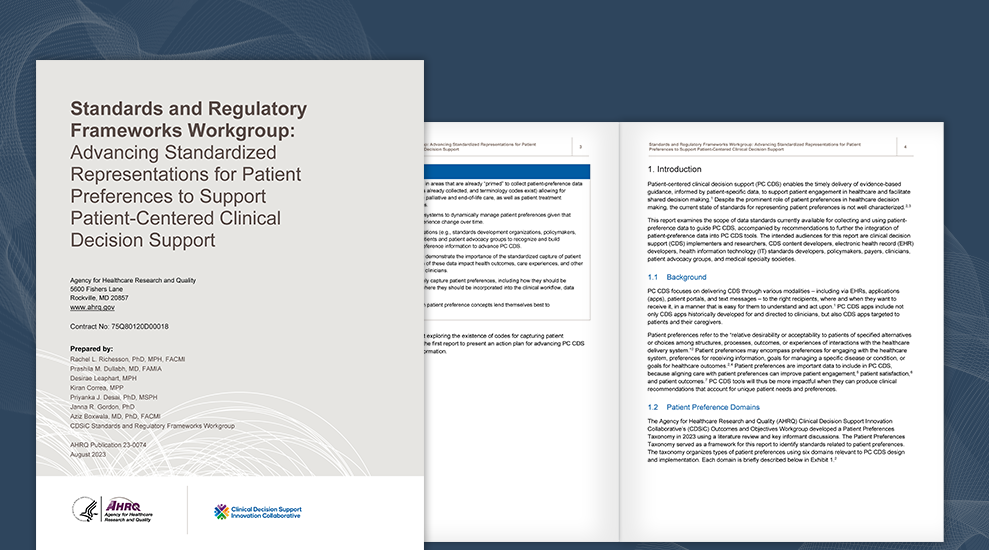
This report describes standards for patient-preferences data.
Developed by the AHRQ CDSiC Standards and Regulatory Frameworks Workgroup, this report examines data standards currently available for collecting and using patient-preference data to guide patient-centered clinical decision support (PC CDS) and includes recommendations to further the integration of patient-preference data into PC CDS tools.
Patient preferences may encompass preferences for engaging with the healthcare system, preferences for receiving information, goals for managing a specific disease or condition, or goals for healthcare outcomes. The objective of this report was to qualitatively explore the current standards landscape for patient preference domains relevant to PC CDS. Standards for capturing patients' preferences for their care are emerging. To better understand the current state of the evolving landscape, this report includes:
- Exemplar PC CDS applications (apps) that collect or use data on patient preferences.
- A high-level characterization of relevant standards for representing patient preferences and potential gaps in coverage.
- An understanding of the data needs and standards requirements for the representation of patient preferences for effective PC CDS, including recommendations to stakeholders.
About the Report
The collection of patient preferences is critical to PC CDS and standardized representations of data on patient preferences can advance the development and implementation of PC CDS applications and the exchange of data needed for more robust and useful tools. Data on patient preferences are not routinely collected or universally available, and there are no required standards for representing or reporting patient preferences. This report identifies opportunities for further advancing standard patient-preference data that can be used for PC CDS, including three key takeaways:
- Data in some patient preference domains were more regularly collected and ready for standardization and automated PC CDS compared to other domains in the Outcomes and Objectives Workgroup: Taxonomy of Patient Preferences.
- Some patient preference domains lacked standards and codes, including preferences related to communication, data use, and engagement.
- Patient preferences evolve over time and standards for capturing this information should reflect this.
How to Use the Report
CDS implementers and researchers, CDS content developers, electronic health record developers, health information technology standards developers, policymakers, payers, clinicians, patient advocacy groups, and medical specialty societies can use the report to:
- Leverage existing relevant data standards for representing patient preferences and raise awareness for inclusion of additional patient preference codes that capture patient preferences related to treatment, intervention, and care experience.
- Develop implementation guidance for developers and implementers, as patient preferences can be represented using one or more standards.
- Conduct research and engage in collaborations to effectively capture patient preferences, including how they should be delivered (worded) for patients and where they should be incorporated into clinical workflows, data capture, and decision making.
- Determine which patient preference concepts lend themselves best to standardization.
Suggested Citation: Richesson RL, Dullabh PM, Leaphart D, Correa KH, Desai PJ, Gordon JR, Boxwala AA, and the CDSiC Standards and Regulatory Frameworks Workgroup. Standards and Regulatory Frameworks Workgroup: Advancing Standardized Representations for Patient Preferences to Support Patient-Centered Clinical Decision Support. Prepared under Contract No. 75Q80120D00018. AHRQ Publication No. 23-0074. Agency for Healthcare Research and Quality; August 2023.





